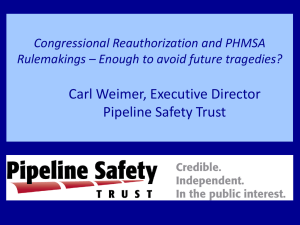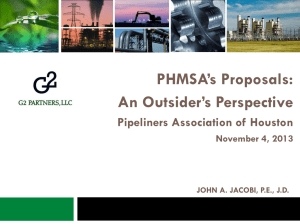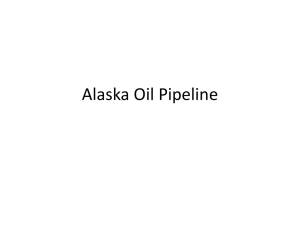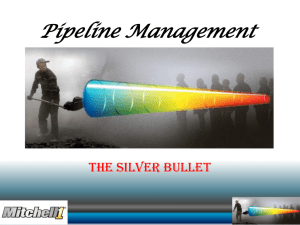Alan Mayberry, PHMSA - Pipeline Safety Trust
advertisement
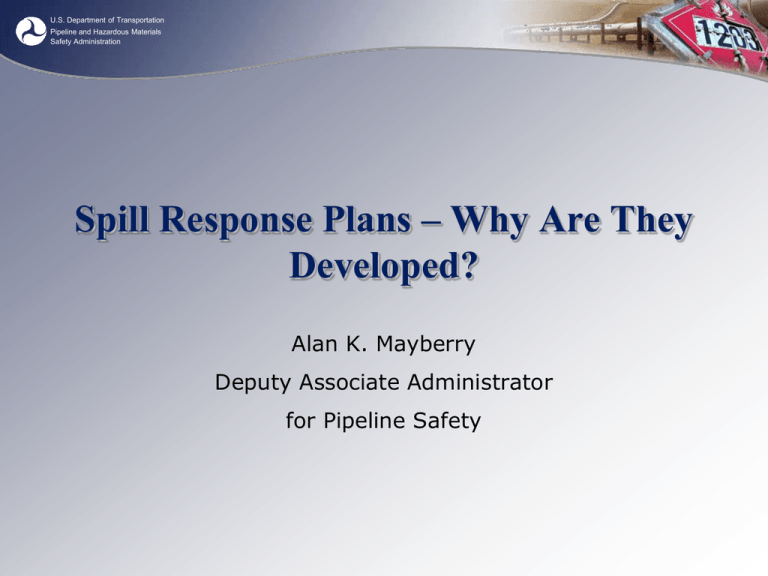
U.S. Department of Transportation Pipeline and Hazardous Materials Safety Administration Spill Response Plans – Why Are They Developed? Alan K. Mayberry Deputy Associate Administrator for Pipeline Safety U.S. Department of Transportation Pipeline and Hazardous Materials Safety Administration Plans required by PHMSA Regulations – Operations, Maintenance and Emergency Manuals • Natural Gas Regulations 49 CFR 192.605 &192.615 • Hazardous Liquid Regulations 49 CFR 195.402 • Liquefied Natural Gas Facilities 49 CFR 193.2503 & 193.2509 – Response Plans for Onshore Oil Pipelines 49 CFR 194.101 U.S. Department of Transportation Pipeline and Hazardous Materials Safety Administration PHMSA Information Sharing Requirements • Pipeline operators must provide information to the public: – Landowners and Rights of Way residents • Public Awareness; • Indications of leaks; • Emergency reporting procedures – Excavators • Damage Prevention and One-Call Information U.S. Department of Transportation Pipeline and Hazardous Materials Safety Administration PHMSA Information Sharing Requirements • Pipeline operators must provide information to the public: – Public assemblies, municipalities, school districts, businesses and residents of pipeline facility locations – Emergency officials • Emergency Plans, Briefings, and Continuing Liaison U.S. Department of Transportation Pipeline and Hazardous Materials Safety Administration PHMSA Information Sharing Requirements • Certain procedures in Emergency manuals may be “Business Confidential or Proprietary.” • Could disclose or illustrate sensitive business processes or practices the operator has developed as a competitive advantage • Business Confidential ≠ Best Practice U.S. Department of Transportation Pipeline and Hazardous Materials Safety Administration What’s in “Emergency Plans?” • Each operator shall establish and maintain liaison with appropriate fire, police, and other public officials to: – Learn the responsibility and resources of each governmental organization that may respond to a gas pipeline emergency – Acquaint the officials with the operator’s ability in responding to a gas pipeline emergency 49CFR.192.615(c) (1),(2) U.S. Department of Transportation Pipeline and Hazardous Materials Safety Administration What’s in “Emergency Plans?” • Each operator shall establish and maintain liaison with appropriate fire, police, and other public officials to: – Identify the types of gas pipeline emergencies of which the operator notifies the officials; and – Plan how the operator and officials can engage in mutual assistance to minimize hazards to life or property 49CFR.192.615(c) (3), (4) U.S. Department of Transportation Pipeline and Hazardous Materials Safety Administration PHMSA Enforces Plan Sharing • In a 2008 case, PHMSA proposed a civil penalty, PHMSA fined a pipeline operator $310,000 for violation of 49 C.F.R. § 195.402(c)(12). • The operator failed to maintain liaison with fire, police, and other appropriate public officials to learn the responsibility and resources of each government organization that might respond to a hazardous liquid pipeline emergency and to acquaint local officials with the operator’s ability in responding to a hazardous liquid pipeline emergency and its means of communication. U.S. Department of Transportation Pipeline and Hazardous Materials Safety Administration PHMSA Enforces Plan Sharing • Our final order states, • “Failure to maintain effective liaison can result in misunderstandings, erroneous expectations, and delayed communications and responses on the part of both the responding local officials and the pipeline operator.” U.S. Department of Transportation Pipeline and Hazardous Materials Safety Administration PHMSA Advisory Bulletin • Published Nov. 3, 2010 • “PHMSA reminds operators of gas and hazardous liquid pipeline facilities that they must make their pipeline emergency response plans available to local emergency response officials.” • “PHMSA recommends that operators provide their emergency response plans to officials through their required liaison and public awareness activities.” • “PHMSA intends to evaluate the extent to which operators have provided their emergency plans to local emergency officials when PHMSA performs future inspections…” U.S. Department of Transportation Pipeline and Hazardous Materials Safety Administration Onshore Oil Pipeline Facility Response Plans (FRPs) • Required by the Clean Water Act, as amended by the Oil Pollution Act of 1990 • Need to address response organization and resources required to respond to a worst case discharge to the maximum extent practicable. • Submitted to PHMSA for review and approval • States may require submission of plans under their own regulations – OPA did not preempt State oil spill laws – State approval process is independent of PHMSA review U.S. Department of Transportation Pipeline and Hazardous Materials Safety Administration Facility Response Plans • Used during spill incidents to guide response, recovery, and removal actions • Can direct operator to share with Federal On-Scene Coordinators • Almost all content is publicly available through Freedom of Information Act requests U.S. Department of Transportation Pipeline and Hazardous Materials Safety Administration Facility Response Plans • FRP must include: – Corporate information and Qualified Individual – Immediate notification procedures – System description or diagrams – Computed worst case discharge on pipeline or at tank facilities – Spill response resources owned by operator or available through contract Oil Spill Response Organization (OSRO) U.S. Department of Transportation Pipeline and Hazardous Materials Safety Administration Facility Response Plans • PHMSA reviews and approves FPRs for 5-year period – Must be updated when significant changes occur – Deepwater Horizon response caused PHMSA to publish an Advisory Bulletin in June 2010 • Most operators’ OSROs were not affected. U.S. Department of Transportation Pipeline and Hazardous Materials Safety Administration Comparison of PHMSA-Required Plans Emergency Plans Facility Response Plans • Required for all pipeline operators • Required for Onshore Oil Pipeline Operators • PHMSA reviews at operator facility during inspections • Operators submit to PHMSA for review and approval • Not collected or maintained by PHMSA • Library of FRPs maintained by PHMSA • Operator must share with local emergency officials • Shared, when requested Federal On Scene Coordinators • Not publicly available through FOIA • Publicly available* through FOIA *Portions may be redacted U.S. Department of Transportation Pipeline and Hazardous Materials Safety Administration Facility Response Plans • Certain FRP information could provide information to an adversary. – Reveal system vulnerabilities and aid target selection – Reveal choke points or non-redundant systems – Maximize damage and interfere / interdict response activities – Some content considered sensitive U.S. Department of Transportation Pipeline and Hazardous Materials Safety Administration Thank you Alan K. Mayberry alan.mayberry@dot.gov 202-366-5124
